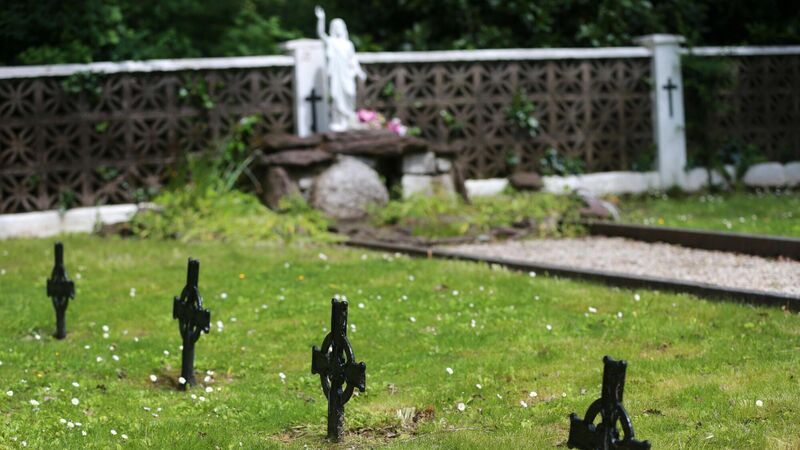The discovery of mass graves is a sure indicator that something evil has happened.
That they are unmarked is another clue.
In Ireland, our experience has largely been rooted in secret burials in unconsecrated ground.
At the former mother-and-baby home in Bessborough, the possible presence of human remains properly obstructs proposals for a €40m apartment scheme.
Investigative work in 2012 by a local historian revealed that hundreds of unnamed children’s bodies were deposited in a disused septic tank on the site of a former institution for unmarried mothers in Tuam in Galway.
It brought international attention to our attitudes and stimulated an ongoing debate nationally.
While the Irish Examiner’s Rural Ireland Thinks poll concluded that 58% of the country’s rural population considers itself religious, there is little doubt that the Irish attitude towards death is overwhelmingly reverential.
This is so despite a similar number of participants in that same survey (57%) declaring broadly in favour of the concept of assisted dying.
The experience in this country of secret graves and burial places is largely confined to the failures of organisations that we have trusted.
Typically, they are the last resting place for the bones of unbaptised babies, women who died in childbirth and out of wedlock, and those judged to be mentally ill or otherwise socially estranged.
Nor are such matters confined to our shores.
In an online article, the visual anthropologist Sabrina Jones describes how the remains of more than 1,000 First Nations children were found near former residential schools in Canada.
In the US, 53 mass burial sites have been identified at former federal Native American boarding schools.
In Europe, unmarked graves of refugees and migrants proliferate.
In Ireland, we have largely been spared the even darker history of warfare, conquest, and genocide that dictators, warlords, and tyrants have attempted to hide over the centuries, and which is now coming to light due to diligent work by scientists and archaeologists utilising newer technologies.
From the forests of Ukraine to the ruins and tunnels of Palestine to Iraq, Rwanda, Bosnia, South America, and Cambodia, teams have worked with modern tools to collate information that will enable the identification of a “verified mass grave” and stimulate further investigation and research.
Because of the volatilities and ever-changing frontiers of conflict, work is accelerating to create the first global open-source mass-graves map.
Its progress is described in The Conversation, the online journal, by legal academics Ellie Smith and Melanie Klinker and encouraged by the International Convention on Missing Persons.
They have also produced a set of protocols establishing international standards on how mass graves should be protected and investigations undertaken.
Such locations are usually crime scenes containing evidence that must be preserved if perpetrators are to be brought to justice — however long that may take.
The sites also contain DNA, which is vital to identify those who have become known generically throughout the world as “the disappeared”.
Many powerful forces prefer that deaths be left undocumented and are aware that disclosure and historical validation can lead to accountability and demands for retribution.
For that reason, what lies beneath must be brought into the light of day.
The benign use of technology is allowing that to happen.
What is the world prepared to do about it?
Writing is on the wall for graffiti
Graffiti has been with us for many millennia and often enriches our lives with social commentary and humour.
Who can resist a smile at the apocryphal story of the church in Liverpool that displayed a sign proclaiming “Jesus Saves”, to which someone had scrawled the addendum: “But St John scores from the rebound.”
Those of our readers who recall the Second World War and its aftermath will remember the ubiquity of the bald-headed, big-nosed, cartoon character overlooking a wall, declaring: “Kilroy was here”.
He was found, to the consternation of Josef Stalin, within the residence of the Russian delegation to the Yalta Conference in 1945, which discussed the post-war reorganisation of Europe.
“Kilroy was stuck here” was inscribed on a bombed-out barn at Bastogne after the Battle of the Bulge.
More contemporaneously, the artist Banksy has become a bankable urban legend.
The costs of graffiti have assumed enormous proportions.
The US pays the equivalent of €10.8bn annually to clean it up, the Australian bill is €1.2bn, and Britain has a similar sum.
While the best graffiti has something to say, the self-aggrandising practice of ‘tagging’ adds nothing to the social landscape or human condition.
Unfortunately, that’s what Cork City has experienced with the defacement of one of its landmark buildings overlooking the River Lee, with ugly spray paint now being removed.
The perpetrators are vandals, not artists, and their activities diminish civic pride.
Perhaps that is what they want.
Make punishment fit the crime
Although we are told that a “seismic” case is taking place which could have a profound impact on the future of professional soccer, the only thing that you can read about it is informed speculation and guesswork.
And that is the way it will be for the next 10 weeks or so as the hearings into financial complaints against Manchester City take place behind closed doors.
The serial winners of the competition over the past seven years — only Liverpool have disrupted their dominance in 2019-20 — face 115 charges in front of an independent commission.
The verdict will come later in the season.

The accusations, all denied, include failure to provide accurate financial information, including player and manager payments, from 2009 to 2018, breaches of Financial Fair Play and Profit and Sustainability Rules, and failure to co-operate with PL investigations from December 2018 to February 2023.
Specific cases concern the contracts of manager Roberto Mancini and influential midfielder Yaya Touré.
Sanctions could include warnings, fines, points deductions, and demotion from the league.
At worst, some of the cherished titles could be wiped out — a subject of interest to Liverpool, Manchester United, and Arsenal, who finished second during some of the seasons under investigation.
At its most draconian, the club could be banned from the Champions League, the FA Cup, the Carabao Cup, and the forthcoming Club World Cup.
It is difficult to gauge because the competitions are overseen by different governing bodies and the rules, particularly in respect of next year’s new tournament, are either opaque or unpublished.
The case is separate from the legal challenge mounted by Etihad against the Premier League’s more recent associated party transaction rules and definitions of fair market value.
In its 165-page legal submission back in June the club, owned by Abu Dhabi royal Sheikh Mansour bin Zayed Al Nahyan, claimed the new regulations were unlawful and attempted to discriminate against Gulf ownership.
In a memorable phrase, they said it was a “tyranny of the majority”. The adjudication is awaited.
While Pep Guardiola delivered a Zen-like response to questions, there are significant issues at stake should City win.

It will potentially widen the competitive gap in the league, and further stretch the differential between the first and second tier.
Relaxing rules could make Premier League clubs even more attractive to venture capitalists and sovereign wealth funds.
These have different views on competition formats, particularly in their attitude to promotion and relegation.
The notion of the “39th game” to be played in the US or the Middle East is likely to return to the table — because the sport doesn’t have enough matches already!
For supporters, this season could potentially end in chaos with the risk of long-running appeals.
The sport has tangled itself into a Gordian Knot which will leave fans bewildered and uncertain.
And perhaps reaching for a new addition to their book of collective anthems and insults: “Fair market value in associated party rules.
“You’ll never sing that.”
CONNECT WITH US TODAY
Be the first to know the latest news and updates
















